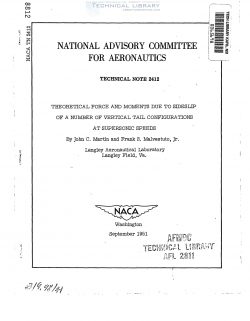naca-tn-2412
- Version
- 102 Downloads
- 1.97 MB File Size
- 1 File Count
- December 14, 2016 Create Date
- December 14, 2016 Last Updated
National Advisory Committee for Aeronautics, Technical Notes - Theoretical Force and Moments Due to Sideslip of a Number of Vertical Tail Configurations at Supersonic Speeds

With the advent of flight at supersonic speeds the dynamic stability
of airplanes has become a serious consideration. ’The conceptions and
usage of the linearized theory of supersonic flow enable an evaluation
of a first-order approximation of the stability derivatives. Stability
derivatives are now available for various wing plan forms at supersonic
speeds. (See bibliography of reference 1 and references,of reference 2.)
Information on the stability derivatives contributed by the vertical
tail, which have an important effect on lateral stability, is lacking.
A theoretical analysis is presented in this paper to determine the
lateral force, the yawing moment, and the rolling moment due to sideslip
for a series of tail configurations that consist of vertical tails
mounted symmetrically on a horizontal tail. The tail configurations
considered herein are characterized by supersonic leading edges.
The vertical-tail plan form may be either triangular, rectangular, or swept-
back with arbitrary taper and sweep; whereas the horizontal tail may be
arbitrary except for the rolling-moment derivative for which case the
trailing edge must be swept at a constant angle. Consideration is also
given to the magnitude of the end-plate effect of the horizontal tail on
the values of the stability derivatives. From a knowledge of the deriv-
ative for the vertical- and horizontal-tail combination and the end-
plate effect on this deriVative, the derivative of a vertical tail with
horizontal tail removed was obtained.’ These results are the lhmits of
the case where the horizontal tail has subsonic edges, and the value of
the stability derivative when the edges of the horizontal tail are
subsonic are expected, therefore, to lie between the values of the deriv-
ative with the horizontal tail (all edges supersonic) attached to the
vertical tail and the values of the derivatives for the vertical tail
alone.
The calculations of the loading distributions that lead to the
sideslip derivatives for nonplanar bodies, such as a tail configuration,
are somewhat complex in the large. For a range of Mach number for which
the leading edges of the tail plan forms are supersonic the load distri-
bution due to sideslip over the horizontal and vertical tail can, however,
be determined rather simply. For a normal tail assemblage, this simplifi-
cation of the analysis results from the fact that the flow fields within
the Mach cone from the apex of the system are physically separated by
the horizontal and vertical tail surfaces and, therefore, do not inter-
.act. The load distributions for such systems may be determined by an
application of planar methods together with the evaluation of the induced
load effects if any.
| File | Action |
|---|---|
| naca-tn-2412 Theoretical Force and Moments Due to Sideslip of a Number of Vertical Tail Configurations at Supersonic Speeds.pdf | Download |

Comment On This Post